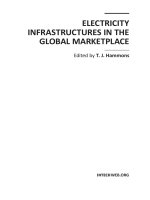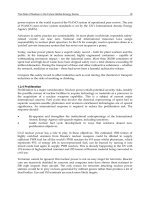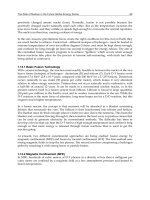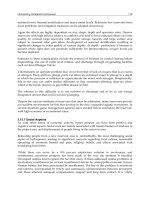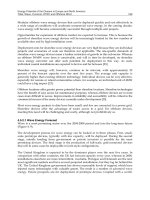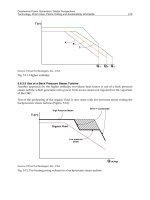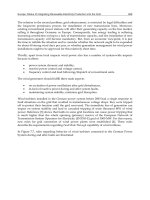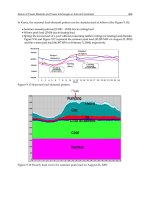Electricity Infrastructures in the Global Marketplace Part 1 potx
Bạn đang xem bản rút gọn của tài liệu. Xem và tải ngay bản đầy đủ của tài liệu tại đây (1.39 MB, 50 trang )
ELECTRICITY
INFRASTRUCTURES IN THE
GLOBAL MARKETPLACE
Edited by T. J. Hammons
Electricity Infrastructures in the Global Marketplace
Edited by T. J. Hammons
Published by InTech
Janeza Trdine 9, 51000 Rijeka, Croatia
Copyright © 2011 InTech
All chapters are Open Access articles distributed under the Creative Commons
Non Commercial Share Alike Attribution 3.0 license, which permits to copy,
distribute, transmit, and adapt the work in any medium, so long as the original
work is properly cited. After this work has been published by InTech, authors
have the right to republish it, in whole or part, in any publication of which they
are the author, and to make other personal use of the work. Any republication,
referencing or personal use of the work must explicitly identify the original source.
Statements and opinions expressed in the chapters are these of the individual contributors
and not necessarily those of the editors or publisher. No responsibility is accepted
for the accuracy of information contained in the published articles. The publisher
assumes no responsibility for any damage or injury to persons or property arising out
of the use of any materials, instructions, methods or ideas contained in the book.
Publishing Process Manager Jelena Marusic
Technical Editor Goran Bajac
Cover Designer Martina Sirotic
Image Copyright TebNad, 2010. Used under license from Shutterstock.com
First published June, 2011
Printed in India
A free online edition of this book is available at www.intechopen.com
Additional hard copies can be obtained from
Electricity Infrastructures in the Global Marketplace, Edited by T. J. Hammons
p. cm.
ISBN 978-953-307-155-8
free online editions of InTech
Books and Journals can be found at
www.intechopen.com
Chapter 1 the Role of Nuclear in the Future Global Energy Scene 1
1.1 Introduction 1
1.1.1 the Greenhouse Eect 1
1.1.2 the Global Scene 1
1.1.3 the Role of Nuclear Today 3
1.2 Public Perception of Nuclear Generation 5
1.2.1 Economics of Nuclear Power 5
1.2.1.1 Future Cost Competitiveness 8
1.2.1.2 Nuclear Fuel Costs 11
1.2.2 Disposal of Nuclear Waste 12
1.2.2.1 Classication of Nuclear Waste 13
1.2.2.2 Management of High Level Waste 15
1.2.2.3 Disposal of High Level Waste 15
1.2.2.4 Management of Low and Intermediate Waste 16
1.2.2.5 Long-Lived Intermediate Level Waste 17
1.2.2.6 Spent Fuel: Reprocessing and Recycling 18
1.2.2.7 Waste From Reprocessing 18
1.2.2.8 Recycling 18
1.2.2.9 Plutonium Recycling 18
1.2.2.10 Uranium Recycling 18
1.2.3 Safety 18
1.2.4 Proliferation 19
1.2.5 Decommissioning of Nuclear Facilities 20
1.3 Advantages of Nuclear Power 21
1.4 Nuclear Power Reactors 22
1.4.1 Components 22
1.5 the Development History of Current Nuclear Reactors 23
1.5.1 Nuclear Power Plants in Commercial Operation 28
Contents
Contents
VI
1.5.2 Nuclear Generating Capacity By Country 28
1.5.3 Nuclear Growth Since 1970 29
1.6 Current Reactor Types 30
1.6.1 Light Water Reactors 30
1.6.1.1 the Pressurized Water Reactor (Pwr) 30
1.6.1.2 Boiling Water Reactor (Bwr) 30
1.6.2 Pressurized Heavy Water Reactor (Phwr Or Candu) 31
1.6.3 Advanced Gas-Cooler Reactor (Agr) 31
1.6.4 Light Water Graphite-Moderated Reactor (Rbmr) 31
1.6.5 Fast Neutron Reactors 31
1.7 Small Nuclear Rectors 32
1.7.1 Light Water Reactors 33
1.7.2 High-Temperature Gas-Cooler Reactors 34
1.7.3 Liquid Metal Cooled Fast Reactors 39
1.7.4 Molten Salt Reactors 42
1.7.5 Modular Construction 43
1.7.6 Floating Nuclear Power Plants 44
1.8 Advanced Nuclear Power Reactors 44
1.8.1 Licensing 47
1.8.2 Light Water Reactors 47
1.8.3 High-Temperature Gas-Cooled Reactors 53
1.8.4 Fast Neutron Reactors 54
1.8.5 Accelerator Driven Systems 56
1.9 Generation Iv Nuclear Reactors 56
1.9.1 Generation Iv International Forum Reactor Technologies 57
1.9.2 Inpro 59
1.9.3 Global Nuclear Energy Partnership (Gnep) 59
1.10 the Hydrogen Economy 59
1.10.1 Nuclear Energy and Hydrogen Production 59
1.11 the Nuclear Fuel Cycle 60
1.11.1 Uranium 61
1.11.2 Uranium Mining 61
1.11.3 Uranium Milling 62
1.11.4 Conversion 62
1.11.5 Enrichment 63
1.11.6 Fuel Fabrication 63
1.11.7 Uranium Requirements 63
Contents
VII
1.12 Thorium As A Nuclear Fuel 65
1.12.1 Thorium R&D History 66
1.12.2 Thorium Power Reactors 67
1.12.3 Emerging Advanced Thorium Reactor Concepts 67
1.13 Nuclear Fusion Power 68
1.13.1 Basic Fusion Technology 69
1.13.2 Magnetic Connement (Mfe) 69
1.13.3 Inertial Connement (Icf) 71
1.13.4 Cold Fusion 71
1.13.5 Fusion History 71
1.13.6 Iter 72
1.13.7 Assessing Fusion Power 73
1.14 Nuclear Energy and Seawater Desalination 74
1.15 Acknowledgements 75
1.16 References 77
Harnessing Untapped Hydropower 79
2.1 General 79
2.2 System Benets 82
2.3 Situation At Present 84
2.4 Prior Development Methods 86
2.5 Review of Selected Regional Prospects 89
2.6 Canada 90
2.7 South and South East Asia 94
2.7.1 Bhutan 94
2.7.2 India 94
2.7.3 Laos 94
2.7.4 Malaysia 94
2.7.5 Myanmar 95
2.7.6 Nepal 95
2.7.7 Pakistan 95
2.7.8 Vietnam 95
Chapter 2
Contents
VII
2.8 Africa 95
2.8.1 Ethiopia 99
2.8.2 Uganda 99
2.8.3 Zambia 99
2.8.4 Mozambique 100
2.8.5 Ghana 100
2.9 Latin America 100
2.9.1 Argentina 100
2.9.2 Brazil 100
2.9.3 Chile 101
2.9.4 Colombia 101
2.9.5 Venezuela 101
2.10 China 101
2.10.1 Precipitation and Topographical
Conditions in Southwest China 102
2.10.2 Prospective Large Projects in Southwest China 102
2.10.3 Associated Transmission 103
2.11 Transmission 103
2.11.1 North America 107
2.11.2 South America 108
2.11.3 Scandinavia 108
2.11.4 India 110
2.11.5 China 111
2.11.6 Africa 112
2.11.7 South East Asia 113
2.12 Environmental 114
2.12.1 River Barriers 117
2.12.2 Alteration of Flow Regimes and Temperature 117
2.12.3 Flow Diversion 118
2.12.4 Sedimentation 118
2.12.5 Nutrients 118
2.12.6 Water Quality 118
2.12.7 Social Aspects 119
2.12.8 A Sustainable Portfolio 120
2.13 Project Development 121
2.14 The Future 122
Contents
IX
2.15 Acknowledgement 128
2.16 References 128
Harnessing Untapped Biomass Potential Worldwide 129
3.1 Introduction 129
3.2 An Overview of Biomass Combined Heat
and Power Technologies 131
3.3 Biomass Availability for Biopower Applications 133
3.3.1 Energy Crops 134
3.3.2 Primary Residues 134
3.3.3 Secondary Residues 134
3.3.4 Tertiary Residues 134
3.3.5 Biomass Potential for 2020 135
3.4 Thermo-Chemical Technologies for Biomass Energy 135
3.4.1 Combustion 135
3.4.2 Gasication 136
3.4.3 Pyrolysis 137
3.5 the Biomaxtm A New Biopower Option
for Distributed Generation and Chp 139
3.5.1 Technology 139
3.5.2 Summary of Biomax Features 141
3.5.3 Comparison of Biomax Bio-Power System With Other Power
Generation Technologies 142
3.6 Motivating the Power Industry with Biomass
Policy and Tax Incentives 143
3.7 Energy Generation Through the Combustion
of Municipal Solid Waste 144
3.7.1 the Concept 144
3.7.2 Technical Challenges 144
3.7.3 Biomass and Renewable Status 145
3.7.4 Public Acceptance 145
3.7.5 Potential 146
Chapter 3
Contents
X
3.8 Senegal Bio Mass Exploitation: An Assessment
of Applicable Technologies for Rural Development 147
3.8.1 Innovative Renewable Energy Technology for Rural Enterprise 147
3.8.2 the Bio-Max System 148
3.9 Acknowledgement 150
3.10 References 150
Energy Potential of the Oceans in Europe and North America:
Tidal, Wave, Currents, Otec and oshore Wind 153
4.1 Introduction 153
4.2 Ocean Wave and Tidal Power Projects in San Francisco 154
4.3 Wave Power Technologies 155
4.3.1 Wave Power Conversion Devices and Technologies 156
4.3.2 Electrical Interconnection 157
4.3.3 Cost 157
4.4 Feasibility Assessment of oshore Wave and Tidal Current
Power Production: A Collaborative Public/ Private Partnership 158
4.4.1 Feasibility of Wave and Tidal Current Energy 159
4.4.2 Wave Project Results 160
4.4.2.1 U.S. Wave Energy Resources 160
4.4.2.2 Feasibility Denition Study Sites 161
4.4.2.3 Feasibility Study - Wec Devices 162
4.4.2.4 Demonstration-Scale Plant Design–Oregon Example 163
4.4.2.5 Commercial-Scale Plant Design –Oregon Example 164
4.4.2.6 Learning Curves and Economics 165
4.5 Recent Progress in oshore Renewable
Energy Technology Development 166
4.5.1 Tidal Energy 166
4.5.1.1 Tidal Forecasts 167
4.5.1.2 Projects 168
4.5.2 Wave Energy 168
4.5.2.1 Wave Energy Forecast 169
4.5.3 oshore Wind 140
4.6 Role of Tidal Power in the United Kingdom
to Reduce Greenhouse Gas Emissions 172
Chapter 4
Contents
XI
4.6.1 Tidal Power 173
4.6.1.1 Physics of Tidal Power 174
4.6.1.2 Types of Tide 174
4.6.1.3 Major Periodic Components 175
4.6.2 European Energy Potential 175
4.6.3 Existing Tidal Energy Schemes 177
4.6.4 Sites Considered for Development Worldwide 177
4.6.5 Harnessing Tidal Power (Flow Or Basin, Existing Tidal Energy
Schemes, Modes of Operation and Conguration, Adaptation of
Tide-Generated to Grid Network Requirements) 177
4.6.5.1 Tidal Flow4.6.5.2 Basin 178
4.6.6 Modes of Operation and Conguration 178
4.6.6.1 Single-Action Outow (Ebb) Generation 178
4.6.6.2 Flood Generation4.6.6.3 Two-Way Generation 178
4.6.6.3 Two-way Generation 179
4.6.7 Tidal Stream 179
4.6.7.1 the Enermax Project (Italy) 179
4.6.7.2 the Blue Energy Project (Canada) 180
4.6.7.3 the Gorlov Helical Turbine (Ght) (Usa) 180
4.6.8 Adaptation to Grid Network Requirements 180
4.7 Proposed Severn Barrage 180
4.7.1 Potential Benets 181
4.7.2 Conditions for Sustainable Development 182
4.7.3 Energy Policy Contexts and Compliance
with Environment Legislation 182
4.7.4 Uk Tidal Resource 183
4.8 Electricity Transmission System 183
4.9 Feasibility Studies: Mersey Estuary, Loughor Estuary (Wales),
Duddon Estuary (Cumbrian Coast), Wyre Barrage (Lancashire),
and Thames Barrier 185
4.9.1 Mersey Barrage 185
4.9.2 Other Uk Barrages 186
4.10 Environment Impact 186
4.11 Carbon Emissions 187
4.12 Physical Implications of A Barrage 188
4.13 Consensus View on Tidal Power in the Uk 189
4.13.1 Tidal Power 189
4.13.2 Tidal Stream 189
4.13.3 Policy Improvements 190
4.13.4 Strategic Planning and Consenting 190
4.13.5 Tidal Lagoons 191
4.13.6 Tidal Barrages 191
Contents
XII
4.14 Acknowledgement 191
4.15 References 191
Geothermal Power Generation: Global Perspectives, Technology, Direct
Uses, Plants, Drilling and Sustainability Worldwide 195
5.1 Introduction 195
5.2 Global Perspective on Geothermal Energy 196
5.2.1 World Energy Consumption 196
5.2.2 Consumption of Renewable Energy Sources 198
5.2.3 Consumption of Geothermal Energy 198
5.2.4 World Energy Resources 201
5.2.5 Cost of Renewable Energy 202
5.3 Geothermal Energy in Usa 203
5.3.1 Tectonic Controls 203
5.3.2 Types of Geothermal Systems 205
5.3.3 U.S. Geothermal Energy Potential 205
5.3.4 Geothermal Energy Use in Usa 206
5.3.5 Operating Conditions for Electrical Generation 206
5.3.6 Direct Use 206
5.3.7 Environmental Constraints 207
5.4 Geothermal Technologies Program:
Us. Department of Energy (Doe) 208
5.4.1 Comprehensive Research Program 208
5.5 Direct Use Geothermal Energy 209
5.5.1 Direct Uses 209
5.5.2 District Heating 210
5.5.3 Agriculture and Aquaculture Applications 211
5.5.4 Future Developments 211
5.6 Improving Geothermal Power Plant 211
5.6.1 Goal and Objectives 211
5.7 Geothermal Drilling R&D Overview 212
5.8 Advanced Power Cycles for Enhancing Geothermal Sustainability 213
5.8.1 Optimization in Design of the Power Cycle 213
5.8.1.1 Heat Cycle Considerations 213
Chapter 5
Contents
XIII
5.8.1.2 Resource Considerations 214
5.8.1.3 Enhanced Geothermal Systems 214
5.8.1.4 Environmental Considerations 214
5.8.2 Conventional Steam Turbine Geothermal Power Plants 214
5.8.3 Geothermal Power Plants Using Organic Rankine Cycle 215
5.8.3.1 Single Phase (Hot Water) Geothermal Power Plants 215
5.8.3.2 Two-Phase Geothermal Power Plant 216
5.8.3.3 Recuperated Organic Rankine Cycle 217
5.8.3.4 Higher Enthalpy Two-Phase Geothermal Power Plant 218
5.8.3.5 Use of A Back Pressure Steam Turbine 219
5.8.3.6 Geothermal Combined Cycle [38] 220
5.8.4 Deployment 220
5.8.5 Enhancing Sustainability and Cost Eectiveness 220
5.9 Iceland Deep Drilling Project, Exploration of Deep
Unconventional Geothermal Resources 221
5.9.1 Supercritical Geothermal Fluids 221
5.9.2 Drilling in Iddp Wells 223
5.9.2.1 Design 223
5.9.2.2 Potential Drill Sites 223
5.9.3 Potential Benets 224
5.9.3.1 Power Generation 224
5.9.3.2 Scientic Studies 224
5.9.3.3 Economic Benets 224
5.9.3.4 Environmental Issues 225
5.9.4. Potential Impacts 225
5.9.4.1 Global Impacts 225
5.9.4.2 Potential Impact on Greenhouse Gases 225
5.10 Geothermal Power Plants in Iceland in the Hengill Area 226
5.10.1 the Hengill Area 227
5.10.2 Nesjavellir Power Plant 227
5.10.3 Hellisheiði Power Plant 228
5.10.3.1 Construction Plan 229
5.10.3.2 Technical Description 229
5.10.3.3 Production Wells and Directional Drilling 230
5.10.4 Hverahlíð and Bitra 230
5.10.4.1 Environmental Policy 230
5.10.4.2 Power Plant At Bitra 230
5.10.4.3 Power Plant At Hverahlíð 230
5.10.5 Research Projects in the Hengill Area 231
5.10.5.1 New Research Areas in the Hengill Area 231
5.10.5.2 Carb-Fix Nature Imitated in Permanent Co2
Storage Project 231
Contents
XIV
5.11 A Perspective on the Future of Geothermal Energy in Usa 231
5.11.1 Future Resources 232
5.12 Acknowledgement 232
5.13 References 233
Reliability Modelling and Assessment of Power System
Operation in the Competitive Electric Energy Market 237
6.1 Introduction 237
6.2 Basic Features of Monte–Carlo Sequential Simulation Approach 238
6.3 Reliability Modelling and Operational Performance of Isolated Power
Systems With An Increased Penetration of Renewable Energy Sources 239
6.3.1 General 239
6.3.2 General Features of Isolated Power System Operation 239
6.3.3 Computational Methodology 240
6.3.4 Assessment Studies 243
6.4. Reliability and Cost Assessment of Power Transmission
Networks in the Competitive Electric Energy Market 247
6.4.1 General 247
6.4.2 Main Features of the Reliability and Cost Allocation Methods 248
6.4.3 Computational Methodology 253
6.4.4 Assessment Studies 256
6.5 Conclusions 260
6.6 Acknowledgements 261
6.7 References 261
Europe: Status of Integrating Renewable Electricity
Production Into the Grid 263
7.1. the German Experience of the Grid Integration
of Renewable Energy Sources 264
7.1.1 Prospective Development of Renewable
Energy Generation in Germany 264
Chapter 6
Chapter 7
Contents
XV
7.1.2 the Economic Incentives 266
7.1.3 Grid Integration of Large Scale Wind Power
in the Transmission Level 267
7.1.4 Dispersed Generation in Distribution Systems 270
7.2. Options for Large Scale Integration of Wind Power 273
7.2.1 Impact of Wind Power on Power System Stability and Operation 273
7.2.2 Case – Local Control 275
7.2.3 Case – Market Based Power Balancing 277
7.3. the Spanish Experience of Grid Integration
of Wind Energy Sources 279
7.3.1 Present Economic Incentives for Wind Energy in Spain [15] 280
7.3.2 the Spanish Experience 283
7.4. From the Kyoto Protocol to the Future Power Grid 286
7.5 Acknowledgement 289
7.6 References 289
Europe: Impact of Dispersed and Renewable Generation
on Power System Structure 291
8.1 Introduction 291
8.1.1 New Challenges 292
8.2 Distributed Generation: Challenges and Possible Solutions 292
8.2.1 Drivers for Dg 293
8.2.1.1 Liberalization of Electricity Markets 293
8.2.1.2 Environmental Concerns 294
8.2.2 Grid Protection and Dg 295
8.2.3 Voltage Quality and Dg 296
8.2.4 Practical Distribution Network 297
8.2.5 Energy Security 304
8.2.6 General Summary 304
8.3 New Tasks Create New Solutions for Communication
in Distribution Systems 304
8.3.1 Basic Principles and Tasks 304
8.3.2 Case Study 306
8.3.3 Communication Standards 307
8.3.4 Design of the Communication Network 309
8.3.5 Benets for Other System Services 311
Chapter 8
Contents
XVI
8.4 Integrating Dispersed Generation Into the Danish Power System 312
8.4.1 System Overview 312
8.4.2 Wind Energy 314
8.4.2.1 Meltra 316
8.4.2.2 Future Requirements for Further Expansion
of Wind Power 317
8.4.3 Chp Units 318
8.4.4 Aspects Concerning the Energy Market 319
8.4.4.1 Sivael 320
8.4.4.2 Demand Response 321
8.5 Further Reading 324
8.6 Acknowledgement 324
8.7 References 324
Status of Power Markets and Power Exchanges
in Asia and Australia 327
9.1 Status of Reform and Power Exchange in India: Trading,
Scheduling, and Real Time Operation Regional Grids 327
9.1.1 Development of Indian Power System 328
9.1.2 Grid Operation 329
9.1.3 Power Exchange 332
9.2. the Inuence of Transmission on Further Development of Power
Exchange in the Australian National Electricity Market 334
9.2.1 Description 335
9.2.2 Issues 336
9.2.2.1 Generation Utilisation 336
9.2.2.2 Resource Development 336
9.2.2.3 Transmission Utilisation 338
9.2.3 Market Developments 339
9.2.4 the Way Forward 339
9.3 Technical and Market System Eectiveness
of Intersystem Power Exchanges in Russia 340
9.3.1 Technical System Eect 340
9.3.2 Market System Eect 341
9.3.3 Principles of Estimating the System Eciency 343
9.3.4 Case Study 343
Chapter 9
Contents
XVII
9.4 Deregulation of Power Systems in Asia: Special Considerations in
Developing Countries 345
9.4.1 Considerations on Power System Deregulation
in Developing Countries 346
9.4.1.1 Targets of Deregulation 346
9.4.1.2 Considerations on the Scheme
of Power System Deregulation 347
9.4.1.3 Consideration on Risks and their Mitigations 348
9.4.1.4 Other Considerations 351
9.4.2 Power Markets in Ne and Nw China 351
9.4.2.1 Northeast Regional Power Market in China 352
9.4.3 R&D for Future Northwest Regional Power Market 353
9.5 East China Power Market Development and Trial Operation 354
9.5.1 the Development of the Market 355
9.5.1.1 Guidelines 355
9.5.1.2 the Principles of Market Design 355
9.5.1.3 the Stage Objectives 356
9.5.1.4 the Trading Arrangements 356
9.5.1.5 Bidding and Market Clearing Mechanism
of Monthly Market 357
9.5.2 Trial Operation of the Market 357
9.5.2.1 Simulation Results 358
9.5.2.2 Results Analysis 361
9.5.3 Lessons and Recommendations 363
9.5.3.1 Regulations and Policies Need to Be Improved 363
9.5.3.2 the Supply-Demand Gap Threatens the Safety
of the Power System 363
9.5.3.3 the Tight Supply Situation Results
in Market Price Rising Rapidly 364
9.5.3.4 Risk Mitigation Methods Need to Be Studied 364
9.5.4 Concluding Remarks 364
9.6 Status and Perspective of Electric Power Industry in Korea 365
9.6.1 Korea Power Exchange 365
9.6.2 Overview of Korean Electricity Industry 366
9.6.3 Measures in Power System Operations 370
9.7 Outlook for Power Exchange Between Russia, Dprk and Rok 372
9.7.1 Power Interconnection Scenarios for “Rfe – Dprk - Rok” 372
9.7.1.1 Potential Local Interconnections Under Discussion 372
9.7.1.2 New Scenarios Including Kedo N/P 373
9.7.2 Estimated Prospective Export/Import Potential 374
9.7.2.1 Power Industry of the Rok 374
Contents
XVIII
9.7.2.2 Power Industry of Dprk 375
9.7.2.3 Rfe Power Balance and Export Potential 375
9.7.3 Admissible Interconnected Capacity in Technical Viewpoints 378
9.7.3.1 Evaluation of Maximum Exchangeable Power 378
9.7.3.2 Evaluation of Minimum Exchangeable Power 378
9.8 Northeast Asia Interconnection, and Power
Flow Considering Seasonal Load Patterns 380
9.8.1 Power System Status and Seasonal Load
Patterns in Northeast Asia 381
9.8.1.1 Power System and Seasonal Load Patterns
in South Korea 381
9.8.1.2 Power System and Seasonal Load Patterns
in North Korea 382
9.8.1.3 Power System and Seasonal Load Patterns
in Far East Russia 385
9.8.1.4 Power System Status in North East China 387
9.8.1.5 Power System Status and Seasonal Load Patterns
of Kyushu in Japan 388
9.8.2 Assumed Possible Interconnection
Scenarios in North East Asia 389
9.8.3 Assumed Seasonal Power Exchange Quantity
for Power Flow Calculation 391
9.9 Acknowledgement 392
9.10 References 392
Power Generation in Southern Africa: Energy Trading
and the Southern African Power Pool 397
10.1 Structure and Governing Documents 397
10.1.1 Sapp Vision 399
10.1.2 Sapp Objectives 400
10.1.3 Sapp Mission, Strategy and Values 400
10.1.4 Sapp Coordination Centre 400
10.1.5 Sapp Membership 401
10.2 Sapp Achievements 402
10.2.1 Coordination Centre 402
10.2.2 Documentation Review and Sapp Restructuring 402
10.2.3 Cooperation With the Regional Electricity Regulatory 402
Chapter 10
Contents
XIX
10.2.4 Transmission Wheeling Charges and Losses 402
10.2.5 Development of A Competitive Electricity Market 402
10.2.6 Completed Transmission Projects 403
10.2.7 Establishment of Westcor 403
10.2.8 Environmental Guidelines 403
10.2.9 Other Completed Projects 404
10.3 Energy Trading 404
10.3.1 Bilateral Contracts 404
10.3.2 the Short-Term Energy Market 405
10.4 Regional Challenges 408
10.5 Acknowledgment 413
10.6 References 413
Electricity Infrastructure in Asian Region and Energy Security Problems 415
11.1 Introduction 415
11.2 Energy Security As A Factor of the Common
Energy Cooperation in East Asia 415
11.3 Energy Security in the Asia-Pacic Region 423
11.3.1 Why Energy Security in Asia 424
11.3.2 A Region At Risk: the Asia-Pacic 425
11.3.3 the Economics of Energy Security 426
11.3.4 Regional Energy Security in the Asia-Pacic 427
11.3.5 Building Energy-Strategic Relationships 428
11.3.5.1 China 428
11.3.5.2 India 428
11.3.5.3 Japan 430
11.3.6 Traditional and Newly Emerging Regional Security Concerns 430
11.3.7 General Notes 431
11.4 Prospects of Electricity Infrastructure in East Asia 432
11.4.1 Creation and Development of Common Electric
Power Space of EA Countries 432
11.4.2 Estimation of Prospective Electricity Demands
of NEA Countries and Free Volumes of their Electricity Markets 434
11.4.3 Export Electric Power Projects of East Russia 436
Chapter 11
Contents
XX
11.5 Assessment of Energy Supply Systems with
an Energy Infrastructure Model for Asia 437
11.5.1 Global Energy Infrastructure Model 437
11.5.1.1 Geographical Coverage and Transportation Network 437
11.5.1.2 System Structure of the Energy Model 438
11.5.1.3 Mathematical Formulation 439
11.5.1.4 Reference Energy Demand Scenario 440
11.5.2 Simulation Results of the Model 440
11.5.2.1 Reference Case Results 440
11.5.2.2 Controlled Case Results 443
11.6 China Power Grid and Its Future Development 444
11.6.1 the Current Situation of China Power Grid 445
11.6.2 Planning of National-Wide Interconnected Power Grid 446
11.6.3 Specic Problems Concerned in National-Wide Power Grid 447
11.6.3.1 Low Frequency Oscillation 447
11.6.3.2 Stability of Receiving Systems 448
11.6.3.3 Security of Multi-in Feed Hvdc Systems 448
11.6.4 Future Development of China Power Grid 449
11.7 Acknowledgement 449
11.8 References 449
Integrated Natural Gas-Electricity Resource
Adequacy Planning in Latin America 451
12.1 Introduction 452
12.2 Electricity and Gas Deregulation 454
12.3 Integrated Gas-Electricity Adequacy Planning in Brazil:
Technical and Economical Aspects 456
12.3.1 the Brazilian Electricity and Natural Gas Sectors 456
12.3.2 Brazil’s Main Challenges in Electricity-Gas Integrated
Adequacy Planning 460
12.3.2.1 the Challenge of Operating Flexibility 460
12.3.2.2 Integrated Electricity-Gas Operations Planning 461
12.3.2.3 Integration of Flexible Lng Supply 461
12.4 Chile: Uncertainty in Natural Gas Supply 462
Chapter 12
Contents
XXI
12.5 Mexico: Growing Interactions Between Mexican
Gas Markets and Electricity System 467
12.5.1 Gas Supply Demand for Electricity Production 468
12.5.2 Gas/Electricity Network Interactions 468
12.5.3 Lng/Electricity Expansion Interactions 469
12.6 Natural Gas and Electricity Market Issues in Colombia 470
12.7 LNG in South America 472
12.7.1 Main Challenges for Lng in Chile 473
12.7.2 Main Challenges for Lng in Brazil 475
12.7.2.1 the Business Model: Lng Flexible Supply 475
12.7.2.2 Challenges for Lng Supply 475
12.7.2.3 Virtual Gas Storage: Gas Stored in Hydro Reservoirs 476
12.7.3 Virtual Gas Storage and Smart Electricity-Gas Swaps 477
12.8 Power and Natural Gas Integration in the
Southern Cone – Past, Present and Future 478
12.8.1 Regulatory and Commercial Situation 479
12.8.2 Southern Cone Integration Issues 479
12.9 Conclusions 480
12.10 Acknowledgements 481
12.11 References 481
Developments in Power Generation
and Transmission Infrastructures in China 483
13,1 Introduction 483
13.2 Main Transmission Projects 484
13.3 Power Grid Development 485
13.3.1 Trans-Regional Power Transmission 486
13.3.2 Construction and Operation of Hvdc Power System 486
13.3.3 750kv and 1000kv Ac Transmission and Substation Project 487
13.3.4 Construction and Operation of Urban and Rural Power Grids 487
13.3.4.1 Enhancing International Cooperation 487
13.3.4.2 Improving Environmental Protection 487
Chapter 13
Contents
XXII
13.3.5 Opportunities and Challenges of National Grid 487
13.3.5.1 Strong Growth in Power Demand 487
13.3.5.2 Economic Performance of Hv Transmission 488
13.3.6 Construction of Hv Transmission Grid 488
13.3.6.1 1000kv Hvac Pilot Project 488
13.3.6.2 Outgoing Hvdc Transmission Line of Jinshajiang River 488
13.3.6.3 Prospect of National Hv Grid 489
13.3.7 South China Hvac/Hvdc Hybrid Grid 489
13.3.7.1 the Rapid Growing-Up of South China Power Grid 489
13.3.7.2 the Unique Features 489
13.3.7.3 the Challenges 490
13.3.8 Future of South China Power Grid 491
13.3.9 Wide Area Measurement System (Wams) 492
13.3.9.1 Wams in China 493
13.4 Diversity in Power Generation 494
13.4.1 Higher Requirements on Resources Exploitation 495
13.4.2 Biomass 496
13.4.3 Natural Gas 497
13.4.4 Coal 498
13.3.4.1 Low Eciency and Large Potential for Energy-Saving 498
13.4.5 Clean Coal Technology in China 498
13.4.6 China’s Clean Coal Technology and Foreign Technology 500
13.4.7 Reasons for Falling Behind in Clean Coal Technology 500
13.4.8 Opportunities for China’s Clean Coal Technology 504
13.5 Obstacles in China’s Clean Coal Technology Acquisition 506
13.5.1 Fewer Joint Ventures in the Field of Clean Coal Technology 506
13.5.2 Restraints on Technology Transfer Strategies
of Multinationals Corporations 506
13.5.3 Low Electricity Price in China 507
13.5.4 Weak Economic Strength of Chinese Companies 507
13.5.5 Strategies for China to Transfer and Develop Clean
Coal Technology 508
13.6 Development of Chinese Power Industry 509
13.6.1 the Clean Development Mechanism (Cdm) 512
13.6.1.1 Market economy development 513
13,6.2 Electricity Taris 514
13.7 R&D on Power System Sponsored By National
Science Foundation China (Nsfc) 516
13.8 Conclusions 517
Contents
XXIII
13.9 Acknowledgement 518
13.10 References 518
Power Generation and Transmission Expansion Planning Procedures
in Asia: Market Environment and Investment Problems 519
14.1 Introduction 519
14.2 Problems of Electric Power System Expansion Planning
in a Market Environment and Procedures of their Solution 519
14.3 Proposed Performance Criteria for Transmission System
Planning Based on Regulating Framework of Twbp in Korea 523
14.3.1 the Progress of Reconstructing in Korea 524
14.3.2 Regulating Framework for Transmission System Planning 524
14.3.2.1 Network Planning Committee 526
14.3.2.2 Business Plan for Transmission Network Development 526
14.3.3 Background to Performance Criteria
for Transmission System Planning 527
14.3.3.1 Development of Performance Criteria 527
14.3.3.2 Performance Criteria for Abnormal State 527
14.3.3.3 Performance criteria for abnormal state 528
14.3.4 Proposed Performance Criteria for Transmission
System Planning 530
14.3.4.1 Performance Criteria for A Normal State 530
14.3.4.2 Performance criteria for a disturbance 531
14.4 Power Generation and Transmission Planning
in India – Methodology, Problems and Investments 532
14.5 Power System and Power Market Development
in China Problems and Proposed Alliviation Measures 535
14.5.1 Power Market Development 537
14.5.2 Generation Planning, Transmission Expansion
Planning and Investment in China 539
14.5.2.1 Energy Shortage Problems and
Proposed Alleviation Measures 540
14.5.2.2 the Proposed Counter Measures 541
14.6 Generation Planning and Investment Under Deregulated
Environment: Comparison of Usa and China 543
14.6.1 Reforming History of the Power Industry in China 543
Chapter 14
Contents
XXIV
14.6.2 Generation Investment 545
14.6.2.1 Generation Investment in the Traditional
Power Industry 545
14.6.2.2 Generation Investment in the Restructured
Power Industry 545
14.6.2.3 Generation Investment in China 547
14.6.3 Risks in Generation Investment 548
14.6.3.1 Risk Distribution 549
14.6.3.2 Eciency Incentives 549
14.6.3.3 Economic Signals 549
14.7 Investment and Development Problems of Russia’s Power Industry 550
14.8 North-East Asia Interconnection Scenario Map,
and Power Reserve Strategy in South Korea 553
14.8.1 Power System in South Korea 554
14.8.2 Power System in North Korea 555
14.8.3 Power System in Far East Russia 555
14.8.4 Liaoning Region Power System in North-East China 555
14.8.5 Power System of Kyushu in Japan 556
14.8.6 Load Flow Calculations 557
14.9 Generation and Transmission Sector in Korean Power Systems 557
14.9.1 Generation Sector in Korea 559
14.9.1.1 Restructuring Plan for Electricity Industry 559
14.9.1.2 Investment in Generation Capacity 559
14.9.2 Transmission System in Korea 560
14.9.2.1 Overview of Current Transmission Network 561
14.9.2.2 Transmission Expansion Planning 561
14.10 Acknowledgement 561
14.11 References 562
Impacts of Ghg Programs and Markets on the Power Industry 565
15.1 Introduction 565
15.2 International Response to Climate Change: An Overview 565
15.2.1 Greenhouse Gases and Climate Change 566
15.2.2 Major Impacts on Power Systems 569
15.2.3 Major Global Programs 570
Chapter 15
Contents
XXV
15.2.3.1 Kyoto Protocol 570
15.2.3.2 Intergovernmental Panel on Climate Change (Ipcc) 570
15.2.3.3 Asia Pacic Partnership on Clean Development
and Climate (App) 571
15.2.4 Other Programs and Initiatives 572
15.2.4.1 Other programs and initiatives 572
15.2.4.2 Canada 572
15.2.4.3 Stern review report main conclusions 572
15.2.5 Other Programs and Initiatives 573
15.2.6 Emissions Trading 573
15.2.6.1 Emerging Ghg Markets 573
15.2.7 Mitigate and/Or Adapt 575
15.2.7.1 Mitigation Priorities for Power Industry 577
15.2.7.2 Adaptation Priorities for Power Industry 577
15.2.8 Section Conclusions 577
15.3 Value of Non-Carbon Power and Emissions Avoidance 577
15.3.1 Nuclear Energy Example 578
15.3.2 Valuing Emissions Reduction 579
15.3.2.1 Economic Value to A Nation and the World 579
15.3.2.2 Economic Value to Investors 579
15.3.2.3 Assumed Value of the Right to Emit 580
15.3.2.4 Actual Trading Value 581
15.3.2.5 Negative Value of Negawatts: Conservation and
Eciency Relative Socio-Economic Values 581
15.3.2.6 the Alternative Or Substitution Value 583
15.3.2.7 Avoidance, Capture and Sequestration Value 584
15.3.2.8 Value of Alternate Technologies 5858
15.3.2.9 Policy Value: Energy Insecurity and Carbon Taxes 585
15.3.2.10 Global Value of Sustainable Avoidance 586
15.3.3 Results 586
15.4. Impact of Regional Greenhouse Gas Initiative and Renewable
Portfolio Standards on Power System Planning 587
15.4.1 Rggi 587
15.4.2 Renewable Portfolio Standards 588
15.4.3 Impacts on Power System Planning 588
15.5 Conclusions 589
15.6 Acknowledgements 590
15.7 References 590
